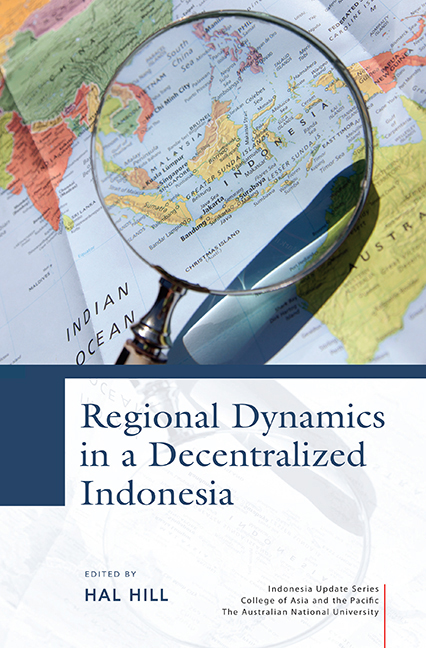Book contents
- Frontmatter
- Dedication
- Contents
- Tables
- Figures
- Contributors
- Acknowledgments
- Glossary
- Map of Indonesia
- 1 An introduction to the issues
- PART 1 HISTORICAL, ECONOMIC, POLITICAL AND SOCIAL PATTERNS
- PART 2 DECENTRALIZATION AND GOVERNANCE
- PART 3 LOCAL-LEVEL PERSPECTIVES
- PART 4 MIGRATION, CITIES AND CONNECTIVITY
- PART 5 CHALLENGES FOR INDONESIA'S PERIPHERY
- 17 The political impact of carving up Papua
- 18 Development in Papua after special autonomy
- 19 Special autonomy, predatory peace and the resolution of the Aceh conflict
- 20 Aceh's economy: prospects for revival after disaster and war
- Author index
- Subject index
- INDONESIA UPDATE SERIES
19 - Special autonomy, predatory peace and the resolution of the Aceh conflict
from PART 5 - CHALLENGES FOR INDONESIA'S PERIPHERY
Published online by Cambridge University Press: 21 October 2015
- Frontmatter
- Dedication
- Contents
- Tables
- Figures
- Contributors
- Acknowledgments
- Glossary
- Map of Indonesia
- 1 An introduction to the issues
- PART 1 HISTORICAL, ECONOMIC, POLITICAL AND SOCIAL PATTERNS
- PART 2 DECENTRALIZATION AND GOVERNANCE
- PART 3 LOCAL-LEVEL PERSPECTIVES
- PART 4 MIGRATION, CITIES AND CONNECTIVITY
- PART 5 CHALLENGES FOR INDONESIA'S PERIPHERY
- 17 The political impact of carving up Papua
- 18 Development in Papua after special autonomy
- 19 Special autonomy, predatory peace and the resolution of the Aceh conflict
- 20 Aceh's economy: prospects for revival after disaster and war
- Author index
- Subject index
- INDONESIA UPDATE SERIES
Summary
INTRODUCTION
Since 2005, one of the most remarkable achievements in global peace making has occurred in the province of Aceh. The former rebel movement, the Free Aceh Movement (Gerakan Aceh Merdeka, GAM), has transformed itself into a largely civilian political movement that competes for power through elections. Political violence has declined dramatically, and most of the violence that does occur is not between Indonesian security forces and GAM supporters as it was during the conflict years. Most observers have ascribed the success of the peace process in part to the autonomy arrangements promised to GAM during the peace talks in Helsinki in 2005. GAM supporters describe these arrangements as ‘self-government’, while representatives of the Indonesian government typically use the term ‘special autonomy’. These arrangements were embodied in Law 11/2006 on the Governing of Aceh a little over a year after the Helsinki peace agreement was signed. It has provided the framework for organizing Aceh's governmental affairs ever since.
While observers are right in attributing the success of the peace process to the compromise reached in Helsinki, and subsequently formalized in Law 11/2006, it would be a mistake to think that the autonomy package represents a set of ingredients that could successfully be transplanted to other conflict zones with similar results, regardless of circumstances. In fact, most of the ingredients had been tried before in Aceh but had failed. Following the fall of the Suharto presidency in 1998, the Indonesian government made several efforts to resolve the Aceh conflict by way of special autonomy, including two laws passed in 1999 and 2001. Many of the elements in the 2006 law had in fact already been included in the 2001 law, but were rejected at the time by GAM leaders as being a poor substitute for independence. Moreover, as we shall see, in several ways the autonomy arrangements put into effect in Aceh have fallen short of GAM supporters’ expectations, and Jakarta retains decisive authority in various areas of Aceh's affairs.
What, then, has made the post-2005 special autonomy deal so successful? I argue that it boils down to a combination of two elements. First are the core political provisions in the Helsinki memorandum of understanding (MOU) and the 2006 law that have allowed GAM to transform itself into a political force and compete for power through elections.
- Type
- Chapter
- Information
- Regional Dynamics in a Decentralized Indonesia , pp. 460 - 481Publisher: ISEAS–Yusof Ishak InstitutePrint publication year: 2014

